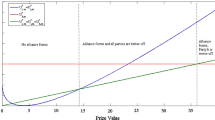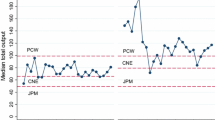Abstract
Many real-world conflicts are to some extent determined randomly by noise, and many also depend critically on the formation of alliances or long-run cooperative relationships. In this paper, we emphasize that the specific manner by which noise is modeled in contest success functions (CSFs) has implications for both the possibility of forming cooperative relationships and the features of such relationships. The key issue is that there are two distinct approaches to modeling noise in CSFs, each with their own merits and each leading to different results depending on which type of alliance formation is under consideration. In a one-shot conflict, we find that when noise is modeled as an exponential parameter in the CSF, there is a range of values for which an alliance between two parties can be beneficial; that is not the case for models with an additive noise parameter. In an infinitely repeated conflict setting, we again find discrepant results: with additive noise, sustaining collusion via Nash reversion strategies is easier the more noise there is and more difficult the larger the contest’s prize value, while an increase in the contest’s number of players can make sustaining collusion either more or less difficult. This is all in marked contrast to the case of an exponential noise parameter, when noise plays no impact on the sustainability of collusion. Given that alliances do occur in both scenarios in the real world, this contrast could be seen as supporting the importance of both specifications.

Similar content being viewed by others
Notes
Other applications of contest models include political lobbying, electoral competition, litigation, advertising competition, R&D competition, and sporting competition.
The restriction on \(\gamma\) is sufficient to ensure an interior pure-strategy Nash equilibrium.
Dasgupta and Nti (1998) also use a similar CSF specification in their study of optimal contest design, but interpret their parameterization as the probability that the contest does not award the prize, which is more like the contests with the possibility of a draw studied by Blavatskyy (2010) and Jia (2012).
We go through the first order conditions for a more complicated version of the model shortly in the paper and the maximization process itself is fairly well-known so we omit the specifics of this version here.
More generally, in a standard n-player contest with a Tullock CSF as in (1) with all parties maximizing their payoffs individually, \(x_i^T=\frac{\gamma (n-1)}{n^2}v\) and \(\pi _i^T=\frac{n-\gamma (n-1)}{n^2}v\) for all \(i\in {I}\).
For a more specific illustration of the derivation of these results we refer readers to the paper’s “Appendix”.
Splitting the prize via second-stage intra-alliance conflict only harms the allies relative to the unallied party, as the additional conflict further dissipates the prize value for the allies.
A Wolfram Alpha link to a graph illustrating this relationship (with v normalized to 1) can be found at https://tinyurl.com/yczg5beb.
A Wolfram Alpha code to illustrate this result, with v normalized to 1 can be found at https://tinyurl.com/y73upr5m.
Similar logic explains why the expected payoff to an allied party \(i\in \{1,2\}\) gets closer to that of the unallied party 3 as noise increases, though the unallied party remains advantaged due its lack of collective action problem, which is somewhat of a paradox.
Wolfram Alpha link here: https://tinyurl.com/y8nmygf2.
There also exist a number of studies that analyze explicit collusion in one-shot contests (e.g., Alexeev and Leitzel 1991, 1996; Huck et al. 2002) and that develop models of infinitely repeated contests to analyze non-collusive behavior (e.g., Itaya and Sano 2003; Mehlum and Moene 2006; Krähmer 2007; Eggert et al. 2011; Grossmann et al. 2011).
It is straightforward to show that the first derivative of (5) with respect to \(x_{it}\) is positive when \(x_{jt}=0\) for all \(j\in {I}{\setminus }{\{i\}}\) and \(\alpha <(n-1)v/n^{2}\), ruling out all players making 0 expenditures as a Nash equilibrium. It is also straightforward to show that (5) is strictly concave in \(x_{it}\).
Numerous studies of collusion in repeated contests follow a similar approach; see, for example, Linster (1994), Amegashie (2006a), Amegashie (2011), Shaffer and Shogren (2008), and Cheikbossian (2012). Therefore, we adopt this approach so that our results on incentives for collusion are comparable to ones already existing in the literature.
It is straightforward to show that (6) is strictly concave in \(x_{it}\).
Shaffer and Shogren (2008) analyze the critical discount rate (\(r^{*}\)) sustaining collusion, which relates to the critical discount factor (\(\delta ^{*}\)) we analyze as \(\delta ^{*}=1/(1+r^{*})\).
Thanks very much to an anonymous reviewer for this interpretation.
References
Abreu, D. (1986). Extremal equilibria of oligopolistic supergames. Journal of Economic Theory, 39(1), 191–225.
Abreu, D. (1988). On the theory of infinitely repeated games with discounting. Econometrica, 56(2), 383–396.
Alexeev, M., & Leitzel, J. (1991). Collusion and rent-seeking. Public Choice, 69(3), 241–252.
Alexeev, M., & Leitzel, J. (1996). Rent shrinking. Southern Economic Journal, 62(3), 620–626.
Amegashie, J. A. (2006a). Asymmetry and collusion in infinitely repeated contests. Working Paper, University of Guelph.
Amegashie, J. A. (2006b). A contest success function with a tractable noise parameter. Public Choice, 126(1–2), 135–144.
Amegashie, J. A. (2011). Incomplete property rights and overinvestment. Social Choice and Welfare, 37(1), 81–95.
Blavatskyy, P. R. (2010). Contest success function with the possibility of a draw: Axiomatization. Journal of Mathematical Economics, 46(2), 267–276.
Cason, T. N., Masters, W. A., & Sheremeta, R. M. (2013). Winner-take-all and proportional-prize contests: Theory and experimental results. Working Paper, Case Western Reserve University.
Cheikbossian, G. (2012). The collective action problem: Within-group cooperation and between-group competition in a repeated rent-seeking game. Games and Economic Behavior, 74(1), 68–82.
Dasgupta, A., & Nti, K. O. (1998). Designing an optimal contest. European Journal of Political Economy, 14(4), 587–603.
Eggert, W., Itaya, J., & Mino, K. (2011). A dynamic model of conflict and appropriation. Journal of Economic Behavior & Organization, 78(1–2), 167–182.
Friedman, J. W. (1971). A non-cooperative equilibrium for supergames. Review of Economic Studies, 38(1), 1–12.
Grossmann, M. (2014). Uncertain contest success function. European Journal of Political Economy, 33, 134–148.
Grossmann, M., Lang, M., & Dietl, H. (2011). Transitional dynamics in a Tullock contest with a general cost function. Journal of Theoretical Economics, 11(1), 17.
Hillman, A. L., & Riley, J. G. (1989). Politically contestable rents and transfers. Economics & Politics, 1(1), 17–39.
Huck, S., Konrad, K. A., & Müller, W. (2002). Merger and collusion in contests. Journal of Institutional and Theoretical Economics, 158(4), 563–575.
Itaya, J., & Sano, H. (2003). Exit from rent-seeking contests. Japanese Economic Review, 54(2), 218–228.
Jia, H. (2008). A stochastic derivation of the ratio form of contest success functions. Public Choice, 135(1), 125–130.
Jia, H. (2012). Contests with the probability of a draw: A stochastic foundation. Economic Record, 88(282), 391–406.
Ke, C., Konrad, K. A., & Morath, F. (2013). Brothers in arms—An experiment on the alliance puzzle. Games and Economic Behavior, 77(1), 61–76.
Konrad, K. A. (2009). Strategy and dynamics in contests. New York: Oxford University Press.
Krähmer, D. (2007). Equilibrium learning in simple contests. Games and Economic Behavior, 59(1), 105–131.
Leininger, W., & Yang, C. (1994). Dynamic rent-seeking games. Games and Economic Behavior, 7(3), 406–427.
Linster, B. G. (1994). Cooperative rent-seeking. Public Choice, 81(1–2), 23–34.
Mehlum, H., & Moene, K. (2006). Fighting against the odds. Economics of Governance, 7(1), 75–87.
Rai, B. K., & Sarin, R. (2009). Generalized contest success functions. Economic Theory, 40(1), 139–149.
Ross, M. (2015). What have we learned about the resource curse? Annual Review of Political Science, 18, 239–259.
Shaffer, S., & Shogren, J. (2008). Infinitely repeated contests: How strategic interaction affects the efficiency of governance. Regulation & Governance, 2(2), 234–252.
Skaperdas, S. (1996). Contest success functions. Economic Theory, 7(2), 283–290.
Tullock, G. (1980). Efficient rent seeking. In J. Buchanan, G. Tullock, & R. Tollison (Eds.), Toward a theory of the rent-seeking society (pp. 97–112). College Station: Texas A&M University Press.
Wasser, C. (2013). Incomplete information in rent-seeking contests. Economic Theory, 53(1), 239–268.
Yang, C. (1993). Cooperation by credible threats: On the social costs of transfer contests under uncertainty. Journal of Institutional and Theoretical Economics, 149(3), 559–578.
Author information
Authors and Affiliations
Corresponding author
Appendix: Comparative statics for the additive noise CSF
Appendix: Comparative statics for the additive noise CSF
In a one-shot, three-party contest with the additive noise CSF specified in (2), each player i maximizes \(\pi _i(x_1,x_2,x_3) = p_i(x_1,x_2 ,x_3)v - x_i\) with respect to their own expenditure \(x_i\), leading to three first order conditions of the form
Solving those three first order conditions for a symmetric equilibrium leads to equilibrium expenditures of \(x_i^*=\frac{2}{9}v-\alpha\), thus equal (\(\frac{1}{3}\)) probabilities of victory, and expected payoffs of \(\pi _i^*=\frac{1}{9}+\alpha\). Note that this is extremely similar to the results from the standard Tullock contest without any alliances, with the noise factor \(\alpha\) modifying things in a very straightforward manner. Also, as with exponential noise, noise decreases expenditures since the CSF is less sensitive to effort and thus increases expected payoffs.
To complete the comparison results from Sect. 2, we now consider a one-shot contest with a modified additive noise CSF so that the two parties who ally have the probabilities of victory equal to
with a complementary unallied \(p_3\). With each party maximizing their corresponding payoff functions, and assuming that the two allies simply agree to split the prize evenly in the event of victory, we then have the first order conditions:
and
The fact that the first two first order conditions are identical is what leads to the inability to solve for \(x_1^*\) or \(x_2^*\) uniquely. This also illustrates what leads to the alliance puzzle results in the alliance model with a Tullock CSF and no noise (\(\gamma =1\)), as in Ke et al. (2013). The first order conditions in that case are the same as those above but without the \(\alpha\) parameters, leading to the equilibrium values in (i), (ii), and (iii).
In the additive noise version, the presence of the additive parameter means solving for analytical solutions leads to quadratic expressions, but the same qualitative results as those in (i), (ii), and (iii) hold in terms of the allies remaining unable to find unique expenditure levels, each therefore having the incentive to free-ride off of the other, and at best ending up the same as in the unallied case.
Rights and permissions
About this article
Cite this article
Boudreau, J.W., Sanders, S. & Shunda, N. The role of noise in alliance formation and collusion in conflicts. Public Choice 179, 249–266 (2019). https://doi.org/10.1007/s11127-018-0564-y
Received:
Accepted:
Published:
Issue Date:
DOI: https://doi.org/10.1007/s11127-018-0564-y




